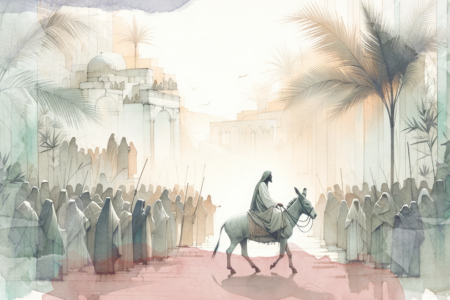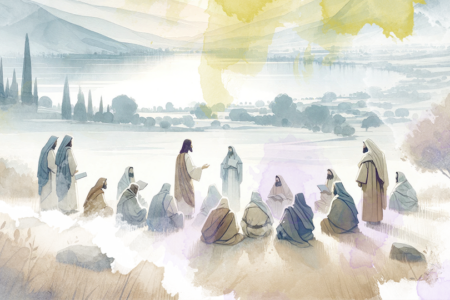Archeology and The Atriarchs
Recent archeological research has done much to confirm and illuminate the historical statements of the Bible.
Archeology has also been useful in helping us fit Bible narrative into the broader context of contemporary world history. By giving us a picture of the social customs and the political situations of the ancient Near-East, it has shed much light on Biblical history. The stories of patriarchs found in Genesis have been amply illustrated and illuminated by recent archeological discoveries.
Are the Patriarchs Historical?
Some scholars have questioned the historicity of the patriarchal stories, regarding them as products of the time of the divided monarchy. These men believed that the tales about the individual patriarchs were originally epic traditions which were developed at “cult centers.” They said that the stories about Abraham grew up at Hebron; those about Isaac at Beer-Sheba. These separate traditions were, the critics said, fused into a single narrative (Gen. 12-50). Writers of the same school also said that the stories portrayed later conditions which existed under the monarchy, and that they were cast into the distant past and made into stories of national origins in order to demonstrate ISrael’s right to the land of Canaan.
Today this view of the Book of Genesis has been abandoned by most modern scholars. Even those, who because of prejudice, would appreciate any evidence against the Bible, have been forced to change their views concerning the patriarchs. In this connection, W. F. Albright, the world renowned archeologist, has said:
“Aside from a few die-hards among older scholars, there is scarcely a single biblical historian who has not been impressed by the rapid accumulation of data supporting the substantial historicity of patriarchal tradition.”1
Although it is true that liberal scholars have been forced to reject their earlier views of the patriarchs and to express a higher opinion of the narratives, it cannot be said that they have become conservatives. On the contrary, they have merely tried to fit their liberal, anti-Biblical views into the context of the new evidence. Since no corroborating evidence was available, they used to deny the truth of the narratives. Now that this evidence is available, they say that the similarities between the Israelite institutions and those of other Near-Eastern peoples prove that there is nothing unique about the religion of Israel. It seems as if the evidence does not affect their conclusions. No matter what the facts were, the critics would find some way of denying the truth of the Scriptures.
into Letthe
Let us now look at some of the archeological findings which fit so well into the patriarchal period and shed new light on the customs of that age.
Adoption
Archeologists have uncovered thousands of clay tablets at the site of the ancient city of Nuzi (or Nuzu) which is located in N.E. Mesopotamia. These tablets date from the middle of the second millenium B.C. They are chiefly business documents, which give us an insight into the social customs of the day. Many of them are adoption contracts. As in Biblical law, property could not be transferred permanently to anyone outside the family. A legal maneuver was therefore invented to circumvent this law. By means of a mock adoption, a person could legally become part of another’s family. The property could then be given or sold within the “family.” By this means wealthy men could become “adopted sons” of poorer landowners and thus gobble up large portions of land.
There were also real adoptions at Nuzi. A couple without children could adopt for a son, a free man or a slave. The adopted son was then obligated to provide for his adoptive parents as long as they lived, also to bury them and to mourn for them when they died. In return, he would inherit their property. Provision was also made for the possibility that the couple might eventually have a natural son. In this case, the natural son was to be the chief heir, This law clarifies for us the relationship between Eliezer and Abraham. Abraham and Sarah had no children. They had evidently adopted a slave who, according to the custom of the day, would be their heir. This helps us to understand Abraham’s appeal to God:
“And Abram said, Lord God, what wilt thou give me, seeing I go childless, and the steward of my house is this Eliezer of Damascus? And Abram said, Behold, to me thou hast given no seed: and, lo, one born in mine house is mine heir.” (Gen. 15:2-3)
That, however, was not God’s plan. He said:
“. . . This shall not be thine heir; but he that shall come forth out of thine own bowels shall be thine heir.” (Gen. 15:4)
God promised him a natural son who, according to law, would be his heir.
The relationship which existed between Laban and Jacob can also be explained on the basis of an adoption agreement. One of the Nuzi tablets in particular parallels the Biblical records in many places. I am quoting this document in full except for the names of the witnesses:
“The tablet of adoption belonging to Nashwi, the son of Ar-shenni: he adopted Wullu, the son of Puhi-shenni. As long as Nashwi is alive, Wullu shall provide food and clothing; when Nashwi dies, Wullu shall become the heir. If Nashwi has a son of his own, he shall divide (the estate) equally with Wullu, but the son of Nashwi shall take the gods of Nashwi. However, if Nashwi does not have a son of his own, then Wullu shall take the gods of Nashwi. Furthermore, he gave his daughter Nuhuya in marriage to Wullu, and if Wullu takes another wife he shall forfeit the lands and buildings of Nashwi. Whoever defaults shall make compensation with 1 mina of silver and 1 mina of gold.”2
It appears as if Laban had no sons when he met Jacob. It was common for a man who had daughters, but no sons, to adopt a man who would become his daughter’s husband. The son-in-law would then be considered heir unless a natural son was born.
Jacob evidently entered Laban’s household as an adopted son and was given his (Laban’s) daughters, Leah and Rachel, as wives. “It is better that I give her to thee, than that I should give her to another man; abide with me.” (Gen. 29:19). This is paralleled by Wullu’s adoption into the family of Nashwi and his marrying Nashwi’s daughter. Laban later had sons of his own: “And he heard the words of Laban’s sons, saying, Jacob hath taken away all that is, our father’s: and of that which was our father’s hath he gotten all his glory.“ (Gen. 31:1). This new state of affairs removed Jacob from the position of chief heir.
When antagonism arose between Jacob and Laban’s sons, Jacob decided to take his family and goods and return to Canaan. When Jacob left Laban, Rachel stole her father’s household gods (Heb.: teraphim). Laban took off in hot pursuit of Jacob. When he overtook him, his major concern was recovery of his teraphim. According to Nuzi customs, these small idols were very significant. Their possession implied headship of the family. In this case, their possession by Jacob would indicate his right to be Laban’s chief heir. The teraphim, and with them the position of chief heir, should have gone to Laban’s sons. This can be seen by referring to Nashwi’s adoption tablet. Wullu was to receive the gods if no sons were born to Nashwi. If Nashwi had a son, he would receive the gods at the time of his father’s death. Rachel obviously stole the teraphim in order to secure Jacob’s preeminence in her father’s house.
Laban’s statement, “These daughters are my daughters, and these children are my children, and these cattle are my cattle, and all that thou seest is mine” (Gen, 31:43), can be understood by the fact that Jacob, as Laban’s adopted son, was under his patriarchal jurisdiction. As an adopted son, he and his entire family belonged to Laban. He did not have the right to leave without Laban’s armission. Laban had a perfect right to punish Jacob for running away, but God had appeared to him (Laban) in a dream and told him not to be harsh with Jacob.
Also paralleled in the tablet is Laban’s insistence that Jacob take no wives other than his daughters
“…If thou shalt take other wives beside my daughters, no man is with us; see, God is witness betwixt me and thee.” (Gen. 31:50)
Other parallels can be found between the Nuzi tablets and the Jacob-Laban story, but these will suffice for our purposes.
Marriage
Some of the marriage customs portrayed in the lives of the patriarchs seem very unusual to those living in our society. But seen in the light of ancient Near-Eastern society, they are just what we should expect.
In Nuzi, as elsewhere in the ancient Near-East, marriage was not for the purpose of companionship, but for obtaining offspring. With this in mind, it does not seem strange that a wife who failed to produce an heir was required to obtain a slave by whom her husband could have children. The marriage contracts even went so far as to specify where the wife was to obtain the slave girl. The interests of the lawful wife, the slave, and the children were protected by law. The wife was protected in that the slave girl was to continue to be her slave. The slave and her children were protected by the provision that the wife was not to expel them from the household. Often a handmaid was given to a bride by her father.
Here is part of a typical contract from Nuzi containing some of these provisions.
“Furthermore, Kelim-ninu has been given in marriage to Shennina. If Kelim-ninu bears (children), Shennina shall not take another wife; but if Kelim-ninu does not bear, Kelim-ninu shall acquire a woman of the land of Lullu (where the better slaves were obtained) as wife for Shennina, and Kelim-ninu may not send the offspring away. . . . Furthermore, Galampa is given as a handmaid to Kelim-ninu. . . .”3
These provisions of ancient law help us to understand the seemingly strange occurrence in the household of Abraham. Sarah, being barren, said to her husband, “Behold now, the Lord hath restrained me from bearing: I Pray thee, go in unto my maid; it may be that I may obtain children by her.” (Gen. 16:2). Though this seems shocking according to present day concepts, Abraham was following the customs of his day when he did as his wife suggested. Rachel, for the same purpose gave her handmaid, Bilhah, to Jacob.
When Ishmael, Hagar’s son, was born, he became the heir in place of Eliezer. After many years had passed, God blessed Abraham and Sarah with a child born in their old age. Issac, the son of Abraham’s lawful wife, became his heir in place of Ishmael.
During Abraham’s life, he had three different heirs, one supplanting the other. The first was a servant whom he adopted (Eliezer); the second son by wife’s handmaid (Ishmael); and the third a natural son by his wife (Isaac).
After the birth of Isaac, Sarah saw Hagar mocking. Concerned with her son’s future, she insisted to Abraham that Hagar and Ishmael be cast out. Abraham, however, was reluctant to comply with his wife’s demands. As we have seen, Nuzi law stated that the wife did not have the right to cast out the child in such cases. Sarah was making an improper demand and Abraham had every reason to refuse her. He did as Sarah requested only after receiving a direct command from God to do so:
“And God said unto Abraham, Let it not be grievous in thy sight because of the lad, and because of thy bondwoman; in all that Sarah hath said unto thee, hearken unto her voice; for in Isaac shall thy seed be called.” Gen. 21:02)
Oral Blessings
In Nuzi as in many societies of the same era, oral dispensations made by a father when death was impending were considered binding. Among the tablets at Nuzi, there is one describing the account of a lawsuit in which two brothers dispute the right of a third brother to marry a certain slave. Part of the document reads as follows:
“Tarmiya, the son of Huya, appeared with Shukriya and Kula-hupi, with (these) two brothers of his, the sons of Huya, in a lawsuit before the judges of Nuzi with reference to the female slave (Sululi-Ishtar), whereupon Tarmiya spoke thus before the judges, “My father, Nuya, was sick and lay on a couch; then my father seized my hand and spoke thus to me, My other sons, being older, have acquired wives, but you have not acquired a wife; so I give you Sulli-Ishtar as your wife.’”4
Witnesses then testified to the truth of Tarmiya’s statements. On the basis of his father’s spoken disposition, Tarmiya was granted Sululi-Ishtar as his wife.
Cyrus Gordon points out that this is like Biblical blessings in that it is (a) an oral will, (b) with legal validity, and (c) made to a son by a dying father.
When Isaac realized that he was soon to die, he sent his son Esau to hunt a deer and to prepare venison, saying that he would bless him. While Esau was hunting, Jacob, at the instigation of his mother, Rebeccah, appeared before his father and, under false pretenses, received the blessing. However, Rebeccah should not have resorted to subterfuge, since God promised Isaac that he would be Jacob’s heir. When Esau came later expecting to be blessed, Isaac was quite distressed, but realized that the blessing was irrevocable:
“And Isaac trembled very exceedingly, and said, Who? Where is he that hath taken venison, and brought it me, and I have eaten of all before thou camest, and have blest him? yea, and he shall be blest. (Gen. 27:33).
The oral blessing was binding and even Isaac himself could not change it. In fact, it would have been binding even if the one receiving it had been a stranger on his deathbed (Gen. 49).
Jacob also made his will in the form of oral dispensations while on his deathbed (Gen. 49).
The Cave of Machpelah
After Sarah’s death, Abraham attempted to purchase a cave in the corner of a field belonging to one Ephron, the Hittite. Abraham desired to purchase only the cave but Ephron said:
“Nay, my lord, hear me: the field give I thee, and the cave that is therein, I give it thee; in the presence of the sons of my people give I it thee: bury thy dead.” (Gen. 23:11)
This demand of Ephron’s can now be understood on the basis of an ancient Hittite law code which was discovered at the site of the Hittite capital of Bog-hazkoy. The code stated that owners of real estate had to perform certain feudal services including the payment of a levy somewhat like our real estate taxes. When the property was sold, these obligations were transferred to the new owners. If, however, only a portion of the property was sold, the responsibilities remained with the original owner.
Abraham was interested in purchasing a burial plot and not a field. Ephron evidently saw in this transaction a means of getting rid of the obligations which went with the land; therefore, he insisted on selling the entire field. Abraham, having a dead body needing burial, had no recourse but to go along with Ephron and purchase the entire field.
It is interesting to note that in the Hittite documents concerning the sale of real estate, the exact number of trees on the land is stated. According to this custom, the trees are mentioned in speaking of Ephron’s sale of the field:
“And the field of Ephron, which was in Machpelah, which was before Mamre, the field, and the cave which was therein, and all the trees that were in the field, that were in all the borders round about, were made sure unto Abraham for a possession in the presence of the children of Heth, before all that went in at the gate of his city.” (Gen. 23:17-18).
Conclusion
In our brief survey of the customs portrayed in Genesis and those prevalent during the first half of the second millenium B.C., we have seen striking similarities. It is obvious that the patriarchs fit perfectly into the social milieu of their age and are not mere fabrications of a later age. This evidence, along with much more which we have not discussed, has squelched the voices of critics who once with confidence spoke against the historicity of the book of Genesis.
The same material has also helped lovers of God’s Word to understand the lives of Bible characters in a way which was impossible before.
It is our prayer that those who read this article may, with a better understanding of the Bible’s historical background, devote themselves to seeking its eternal message.
ENDNOTE
- The Biblical Period from Abraham to Ezra, Harper & Row, New York, 1949.
- Theophile J. Meek in Ancient Near Eastern Texts Relating to the Old Testament, James B. Pritchard, ed. (Princeton, 1955), P. 219, 220.
- Pritchard, op. cit., p. 220.
- Pritchard, op. cit., p. 220.






